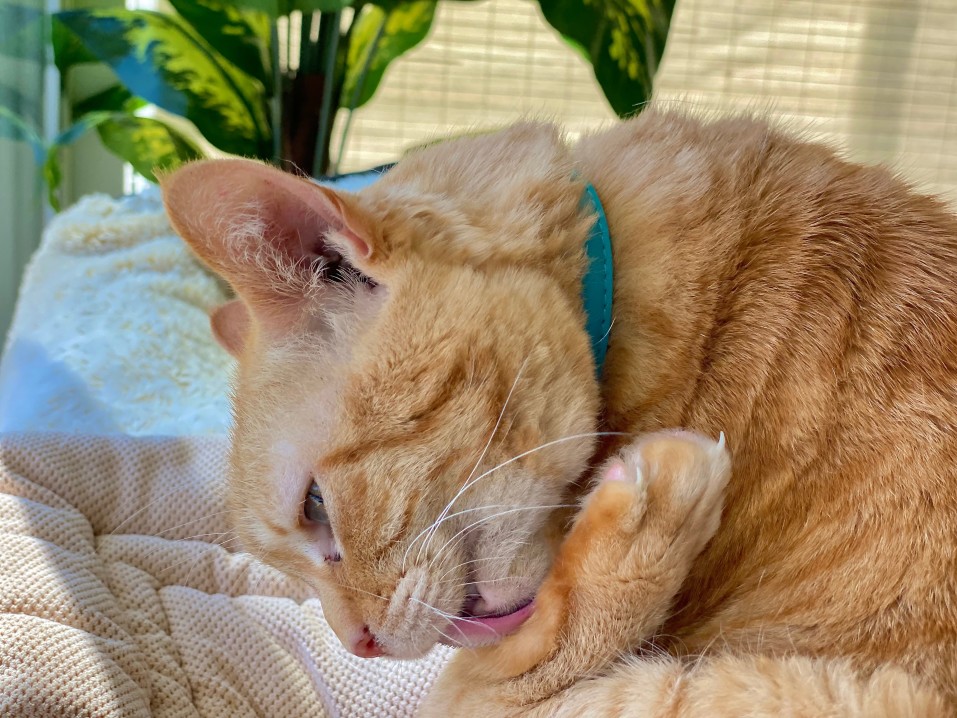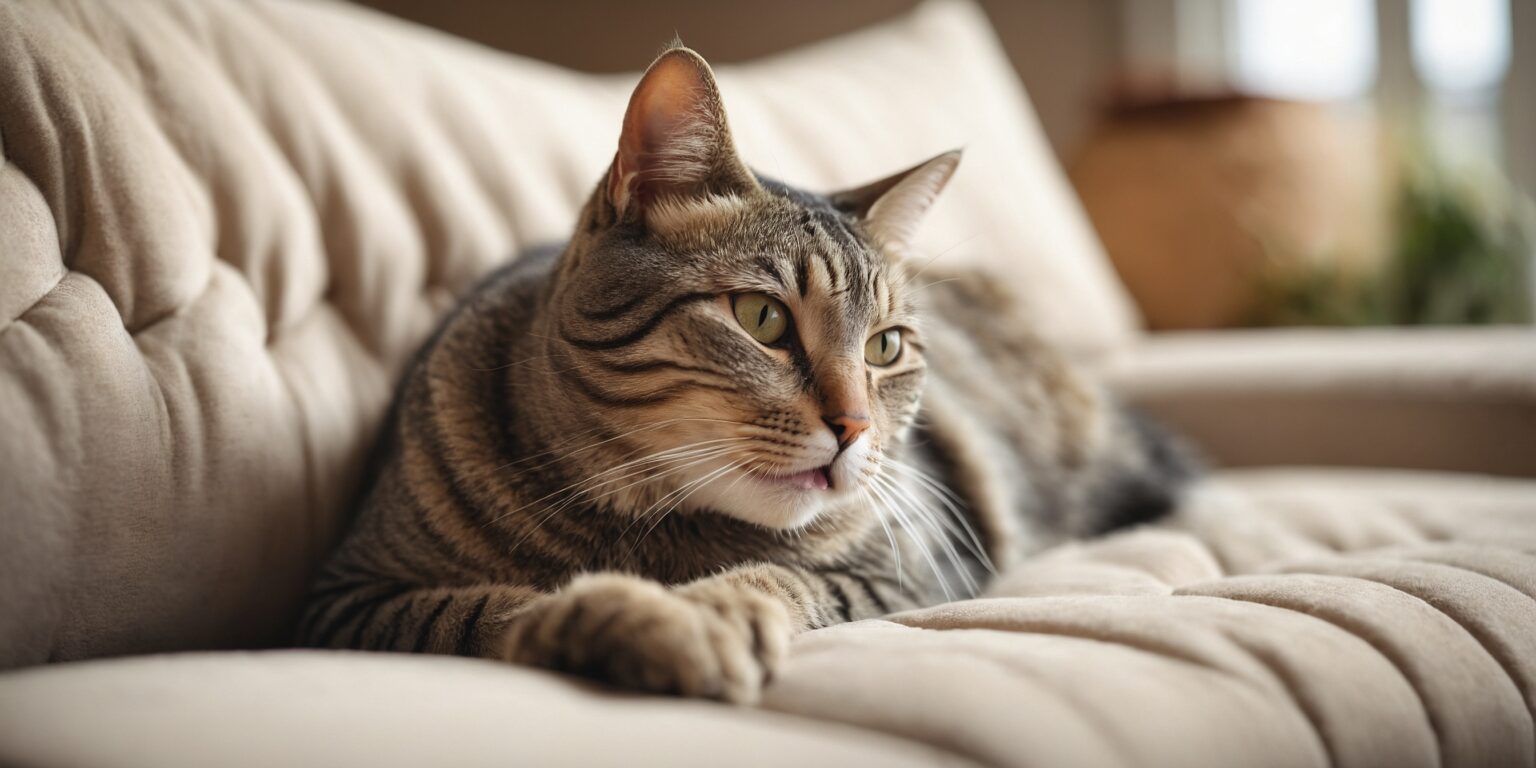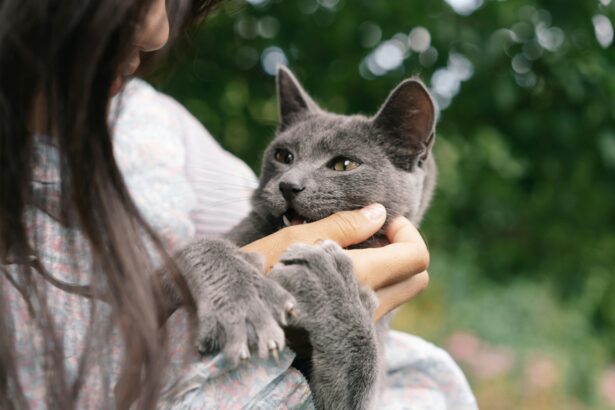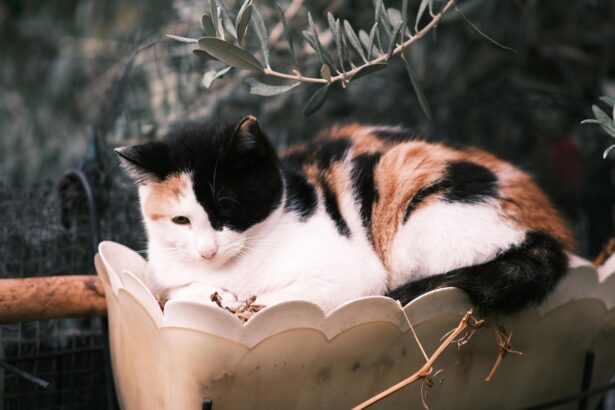Does your cat nibble blankets, lick the same spot forever, or zoom across the living room for no reason? You’re not alone. These odd loops may be stereotypies: repetitive behaviors that signal discomfort and deserve a gentle, curious look.
What is a stereotypy in cats?
A stereotypy is a repetitive, rigid behavior with no clear goal (biting, licking, running, meowing). It often grows from stress, boredom, or anxiety, and sometimes from pain or a neurological issue.
In short, your cat is “saying” something in cat language. Watching the context (when, where, after what) is your best clue. Not sure which signals matter most? See the signs of stress in cats.
The main families of stereotypies
- Self-directed: pulling fur, nibbling skin, overgrooming until lesions appear.
- Locomotor: repeated sprints, sudden jumps, twitchy runs.
- Oral: chewing, licking, swallowing objects (risk of obstruction).
- Vocal: persistent meowing or plaintive cries without an obvious cause.
The most common stereotypies at home
Chewing fabrics (wool-sucking)
Some cats adopt a blanket or sweater and chew it into shreds. The risk? Ingesting fibers that upset digestion. Put tempting textiles away, supervise, and offer safe oral outlets (chew toys, lick mats).
Good to know: this habit, sometimes linked to early weaning, often eases with calming routines and suitable oral enrichment. For the kneady side of things, here’s why cats knead and what it means.
Endless kneading
Kneading is soothing… until it isn’t. If it becomes hard to interrupt (agitation, vocalizing), you may be seeing a stereotypy and underlying stress. Keep a diary to spot patterns: time, place, and what just happened.
Astuce you’ll love: make a “comfort square.” Velcro a small fleece pad to a stable spot (near a perch) and rub it with your scent. Many cats switch from fabric chewing to this safe, personal comfort object.
Constant grooming

Grooming is vital, but when it fixates on one area and intensifies—think bald patches, redness, or sores—it’s a red flag. Pain, itching, or anxiety can all play a role.
Create a “zen nook”: a hideaway, scratching post, soft light, and a pinch of catnip. Short pre-meal hunt games (2–3 minutes) often reduce overgrooming by channeling energy. Curious about herb magic? Explore this complete guide to catnip.
Feline hyperesthesia
Rippling skin along the back, flinching at touch, sudden dashes, self-biting—any single sign can be normal. When they repeat in sequence, check with your vet to rule out pain or skin issues.
Chasing the tail
For kittens, it’s a game. In adults, repeating the chase until injury points to a stereotypy and warrants a veterinary check-up.
When and why do they appear?
At any age and in any breed. Environment and routine matter: boredom, solitude, sudden changes (a move, schedule shifts), inter-cat tension, too few outlets (play, scratching, hiding places).
Adding a new pet can also set things off. A slow, scent-first introduction helps immensely—follow this step-by-step guide to introduce a new cat without conflict.
Common causes to consider
- Stress, anxiety, boredom, loneliness: the top triggers.
- Little socialization or shaky routines: predictability soothes cats.
- Poor enrichment: not enough perches, hides, scratchers, or chase-style play.
- Pain or medical problems: itchiness, dental pain, joint discomfort—veterinary input is vital.
- Family changes: a baby, new partner, renovations, or unusual noise.
Not every lick means stress—sometimes it’s social bonding or taste exploration. If you’re curious about the sweet side of licking, read why cats lick us.
How to help your cat day by day
- Spot the trigger: note the time, place, and what happened just before. Mini journaling reveals hidden patterns.
- Health first: sores, hair loss, pain, or escalating behavior = call your vet.
- Enrich the world: add vertical space, varied scratchers, hideouts, wall walks, forage mats, slow/interactive feeders.
- Daily hunt play: 2–3 short sessions with a wand toy, then a tiny snack to “finish the hunt.”
- Original DIY: build a “scent trail.” Hide 5 cotton pads lightly rubbed with a favorite treat pouch around the room; place a single kibble beside each pad. Your cat follows the scent, earns small rewards, and resets calmly in 10 minutes.
- Support control needs: predictable routines (meals, play, rest) and stable quiet zones.
- Pheromone diffusers: helpful during changes, but never a replacement for enrichment.
Common mistake to avoid: punishing, spraying water, or yelling. It spikes stress and worsens the loop. If your cat sheds more than usual due to grooming, combine calm routines with gentle care from this cat grooming guide.
Bonus pitfall: laser-only play without a “catch.” Always end with a toy the cat can bite and a tiny treat—otherwise frustration can fuel compulsive chasing.
When should you see a specialist?
If the behavior persists, intensifies, causes injury, weight loss, or crowds out normal life (play, sleep, cuddles), talk to your vet. A feline behaviorist can then tailor a plan of environmental tweaks, routine upgrades, and gentle behavior therapy.
Fun fact
Kneading likely comes from a kitten reflex to stimulate milk flow. In adulthood, it’s a cozy throwback—a comfort ritual, as long as it doesn’t tip into compulsion.
FAQ
How do I recognize a stereotypy in my cat?
Look for repetitive actions with no clear goal that are hard to interrupt, often tied to stress. Signs like hair loss, redness, or sores are alerts to act.
What natural ways help calm cat stereotypies?
Predictable routines, short hunt games, rich environments, safe hideaways, and pheromones. Start with stress reduction and daily outlets.
How can I safely stop fabric chewing?
Store tempting textiles, offer chew-safe toys and lick mats, and add calming rituals. If it persists or worsens, consult your vet.
Is feline hyperesthesia dangerous?
Not always, but it can be uncomfortable. Rule out pain or skin disease with your vet, then manage stress and enrichment at home.







